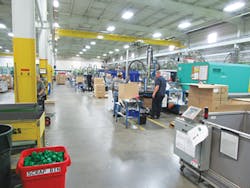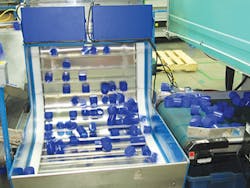Molder Cobra churns out large number, variety of caps
Cobra Plastics Inc. specializes in molding caps for aerosol cans in hundreds of sizes and types and in thousands of colors, and it can deliver a big order in less than a week.
"When a big customer needs an order in five days, we have to have the entire supply chain ready," said Marty Binder, President and COO of Cobra in Macedonia, Ohio. That means having resin, colorant, corrugated boxes, molds and machines available. One paint customer orders caps in about 450 different colors, which Cobra maintains in its inventory of 4,500 colors.
Cobra has been in business under the current ownership for almost 24 years and, although it takes on some custom molding work, it has remained focused on aerosol caps. Binder said Cobra is the second-largest aerosol cap manufacturer after Berry Global Inc., a $7 billion packaging giant.
"They are a lot bigger, but we are a worthy competitor," he said. Cobra does not disclose annual sales.
Made with PP and PE, Cobra's aerosol caps are placed atop personal, household, food, paint, automotive and industrial products. In all, the company produces more than 500 million caps a year.
It all began in 1995, when CEO and owner Kent Houser took over a struggling aerosol cap maker that had seven employees, four molding machines and molds with many non-working cavities. The company slowly grew and, in 2008, it added a state-of-the-art plant about a half-mile down the road from the original location.
Today, Cobra has more than 20 molding machines running in the two plants, and it employs 120 people on three shifts operating 24/5.
Most of the molding machines have about 350 tons of clamping force. Arburg is the predominant brand, but the company also runs machines by other makers, including Engel and Demag. Three KraussMaffei presses are about 22 years old, but the other presses are considerably newer, with an average age of 5 to 10 years old.
The company acquired a 400-ton Netstal in 2017. "It had all the bells and whistles we needed," Binder said. "The platen size was nice for us because we can put a 16-cavity or 24-cavity mold in there. It offers flexibility, which is absolutely important to us."
Binder said that before Cobra purchased the Netstal, employees evaluated several major brands, including Arburg, Engel and Sumitomo Demag. "We compared features and prices and talked to our processors to get their buy-in," he said.
This is Cobra's first Netstal.
"Netstal was able to get the right press, at the right price, at the right time," Binder said. "We have been very happy with it."
Cobra will soon order another molding machine, probably to replace an older unit. Binder declined to give details on the next press.
"Our business model is based on service as our competitive advantage," said Matt Brewer, Cobra's director of operations. "When it comes to specifying equipment, it has to support that model. We run machines at fast cycle times. When a mold is opening and closing that fast, a lot of energy is being absorbed by the machine. For that machine to survive, it has to be properly spec'd out in the beginning. That is why the selection process is so important for us."
Brewer said reliability, ease of repair, availability of repair parts and support from the manufacturer are important factors.
Blenders are mostly from Maguire Products Inc., but the most recent purchases have been from Plastrac Inc., Binder said.
Small caps are bulk-packed in boxes for shipment to customers. Each box is weighed as it is being filled to get the correct number of caps.
But most caps come out of the molding machine and are sorted and oriented. A robot then picks up the caps and deposits them into a shipping carton. Cobra builds most of its own layer packers, which are integral to the operation.
The company is currently having two outside consultants evaluate all its injection molding machines. The evaluations determine what needs to be done to a machine, what it will cost and whether it is a good investment to upgrade.
Brewer said every press gets a general inspection that includes a look at the hydraulic, pump and heat-exchange systems; clamps; platens; and base mechanics to determine if the machine is level and square. If there is a particular problem with a molding machine, someone performs a more focused inspection to try to determine what is wrong.
"These guys are out and about in the industry, so we get a good comparison as to how our presses are operating and what kind of shape they are in versus other companies' machines," Brewer said.
With the high volumes that Cobra runs, the ability to optimize each second is important.
"If you are running 24-second cycle times, does it matter if you run 25 seconds?" Binder asked. "But we are running fast cycle times. The machines we have that are 20 years old cannot compete with a new machine. We have to be price-competitive, so we have to make sure we are running as efficiently as possible."
Cobra built its main plant in 2008 and buried water lines from a central chiller to each molding machine. The chiller, built by Thermal Care Inc., is a refrigerant-based system that cools the molds and presses. It has a 5-micron filter system, automatic backflush and magnetic bearings that do not require grease, oils or other maintenance. Water comes into the chiller at 62 degrees Fahrenheit and goes out at 55 degrees.
It is not a true closed-loop system because water lost during mold changes must be replaced.
The central chiller system saves energy and having the water lines buried adds to the savings, Houser said.
The plant was built using green initiatives, such as the central cooling system, buried water lines and T5-rated fluorescent lighting that requires less energy. The building's design also includes abundant natural light.
It has a railcar siding and resin silos, which reduces truck deliveries.
"I could not put a pen to the green initiatives and say I would get a payback in a certain period of time," Houser said. "But I knew it was the right thing to do. The only thing I can compare are the electric bills. In the old building, our electric bill was about $55,000 a month. In the new building, we doubled the number of machines and tripled the size of the facility, and our electric bill is still about $55,000 a month. Looking back, it was a good decision."
Once the new plant became operational in 2008, Cobra spent about $2 million renovating the old location. In all, Cobra has more than 150,000 square feet of manufacturing and warehousing space.
"A lot of our customers ask us for a contingency plan," Houser said. "If they ask what you would do if something happened to this building, our answer is that we would run their job at the other building." He said it was a strategic decision to maintain two separate manufacturing locations.
A central chilling system was added to the older plant, but the lines are not buried.
Cobra depends on an enterprise resource planning (ERP) system from IQMS. Real-time data from every molding machine and layer packer is available on mobile devices, desktops and big screens inside the plants. Particularly important is the length of time until the end of a run on each press. That tells operators how much time they have until the next color or label change.
In addition to the production data captured by the IQMS system, operators inspect a full-shot sample every hour, supported by a full quality-assurance (QA) inspection every four hours. QA inspection samples are stored for six months.
Cobra practices lean manufacturing, and Binder said the company is adopting scientific molding practices.
Scrap from the molding operation is ground up and sent out to be pelletized. The pellets are returned and used by Cobra. The grinder is from Gloucester Engineering Co. Inc.
Cobra also does silk screening on a small percentage of its products.
Cobra runs some custom projects, including manufacturing a personal care product that requires in-mold labeling and features a flexible "living" hinge. Ilsemann Automation GmbH built the mold-tending robot and DDS Automated Machinery Inc. built the packaging robot. The hinge must be flexed when the container comes out of the mold to give it memory.
The cell also features a camera inspection system.
Another custom project is a 2-piece dispensing closure for a flammable fluid container. It has a base and nozzle and each closure must be leak tested after it is assembled.
The company's expertise, though, is in its ability to churn out a large number and variety of caps.
Cobra makes all caps when they are ordered and does not make caps based on anticipated demand. It refers to the caps as standard products because the industry has standardized many sizes and configurations.
Still, there are a lot of permutations.
Managing thousands of in-stock colors and more than 100 sizes and designs of caps, Cobra has developed its prowess for mold changes. It has about 60 active molds and makes about 10 mold changes per day. The biggest mold has 48 cavities.
The company performs as many as 30 color changes a day. Binder said Cobra's molds are specifically designed to allow for quick color changes.
"After a color change, we are up and running good parts in about five shots. It should only take about 15 minutes," he said.
For a market that requires fast delivery of so many variations of products, change is the one constant. Cobra thrives on meeting the demand.
"Our philosophy is all about service," Binder said. "People talk about quality, price and service. The only one of those that is non-negotiable is service."
Ron Shinn, editor
Contact:
Cobra Plastics Inc. Macedonia, Ohio, 330-425-4260,
About the Author
Ron Shinn
Editor
Editor Ron Shinn is a co-founder of Plastics Machinery & Manufacturing and has been covering the plastics industry for more than 35 years. He leads the editorial team, directs coverage and sets the editorial calendar. He also writes features, including the Talking Points column and On the Factory Floor, and covers recycling and sustainability for PMM and Plastics Recycling.




